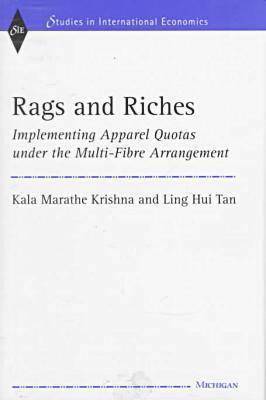
- Afhalen na 1 uur in een winkel met voorraad
- Gratis thuislevering in België vanaf € 30
- Ruim aanbod met 7 miljoen producten
- Afhalen na 1 uur in een winkel met voorraad
- Gratis thuislevering in België vanaf € 30
- Ruim aanbod met 7 miljoen producten
Rags and Riches
Implementing Apparel Quotas Under the Multi-Fibre Arrangement
Kala Marathe Krishna, Ling Hui Tan
€ 161,45
+ 322 punten
Omschrijving
The Multi-Fibre Arrangement (MFA) is among the most important nontariff trade barriers facing developing countries today. Originating more than twenty years ago, it uses product-specific quotas intended to encourage the expansion of trade, reduce barriers, and further the liberalization of world trade in textile products. It has been argued, however, that the MFA may cut off access to major export markets for developing countries, thereby short-circuiting their industrialization process at an early stage.
The authors endeavor to fill several gaps in the literature on the MFA. First, they more closely examine the various quota implementation rules and their implications by describing how the details of quota implementation differ across countries, modeling some aspects of implementation, and attempting to relate some of the results to actual data. Second, by considering alternative theoretical setups and undertaking some simple econometric tests, they look into the possibility that exporting countries may be receiving less quota rent than suggested by the standard competitive model. A selected number of exporters to the United States--including Hong Kong, Korea, Indonesia, India, and Mexico--serve as case studies.
Kala Krishna and Ling Hui Tan conclude that the process of quota implementation begins with an initial system of regulations, drawn up in order to meet certain desirable objectives. But over time, as loopholes are discovered in the system, additional layers of regulation continue to be introduced, resulting in a complicated, discretionary system that no longer meets the original objectives.
Kala Krishna is Professor of Economics, Pennsylvania State University. Ling Hui Tan is an Economist, International Monetary Fund.
The authors endeavor to fill several gaps in the literature on the MFA. First, they more closely examine the various quota implementation rules and their implications by describing how the details of quota implementation differ across countries, modeling some aspects of implementation, and attempting to relate some of the results to actual data. Second, by considering alternative theoretical setups and undertaking some simple econometric tests, they look into the possibility that exporting countries may be receiving less quota rent than suggested by the standard competitive model. A selected number of exporters to the United States--including Hong Kong, Korea, Indonesia, India, and Mexico--serve as case studies.
Kala Krishna and Ling Hui Tan conclude that the process of quota implementation begins with an initial system of regulations, drawn up in order to meet certain desirable objectives. But over time, as loopholes are discovered in the system, additional layers of regulation continue to be introduced, resulting in a complicated, discretionary system that no longer meets the original objectives.
Kala Krishna is Professor of Economics, Pennsylvania State University. Ling Hui Tan is an Economist, International Monetary Fund.
Specificaties
Betrokkenen
- Auteur(s):
- Uitgeverij:
Inhoud
- Aantal bladzijden:
- 264
- Taal:
- Engels
- Reeks:
Eigenschappen
- Productcode (EAN):
- 9780472109340
- Verschijningsdatum:
- 9/11/1998
- Uitvoering:
- Hardcover
- Formaat:
- Genaaid
- Afmetingen:
- 161 mm x 236 mm
- Gewicht:
- 589 g

Alleen bij Standaard Boekhandel
+ 322 punten op je klantenkaart van Standaard Boekhandel
Beoordelingen
We publiceren alleen reviews die voldoen aan de voorwaarden voor reviews. Bekijk onze voorwaarden voor reviews.










